How to Overcome Issues in Homestead Gardening
How to Overcome Issues in Homestead Gardening
Blog Article
Learn Just How to Cultivate a Prospering Horticulture Setting for All Skill Levels
Creating a flourishing yard is a complex endeavor that can be welcomed by individuals at any type of ability degree. By analyzing essential components such as soil wellness, ideal plant option, and seasonal care regimens, one can create a lasting horticulture practice that yields enjoyable results.
Recognizing Your Garden Space
In the realm of gardening, comprehending your yard room is vital to cultivating a growing landscape (Homestead Gardening). The first step in this endeavor includes assessing the details features of your story. Aspects such as dirt composition, sunshine exposure, and drainage play important duties in identifying the suitability of your yard for numerous sorts of plants
Begin by carrying out a soil examination to assess pH degrees and nutrition web content, which will certainly inform any type of necessary modifications. Furthermore, observe exactly how much sunlight your space gets throughout the day. Different plants have varying light demands; some prosper in complete sunlight, while others favor partial or full color.

Finally, review the offered room and plan appropriately. This consists of considering plant elevations and spread to make certain appropriate area for growth without overcrowding. By gaining an extensive understanding of your yard area, you established the foundation for an effective horticulture experience.
Selecting the Right Plant Kingdoms
Choosing the right plants for your yard calls for cautious consideration of different variables, consisting of environment, dirt conditions, and individual preferences. Begin by evaluating your local environment, as particular plants thrive in specific temperature varieties and weather condition patterns. As an example, exotic plants might not endure in cooler areas, while durable perennials can stand up to extreme winter seasons.

Consider your personal preferences, including aesthetic charm and maintenance levels. Determine whether you favor vivid blossoms, rich foliage, or edible crops. Additionally, aspect in the time and initiative you are willing to invest in plant treatment, as some selections demand more attention than others.
Finally, assume concerning the garden's format and light exposure. Sunlight patterns throughout the day will influence your choices-- some plants call for complete sun, while others prosper in color. By attentively examining these aspects, you can produce a productive and unified garden customized to your setting and preferences.
Necessary Horticulture Tools
A well-equipped gardener can dramatically enhance their horticulture experience and end results. Necessary horticulture devices are basic to cultivating a successful yard, despite skill level. First, a tough spade is indispensable for digging and turning dirt, while a trowel permits accurate growing and transplanting of smaller plants.
Trimming shears are essential for preserving plant wellness by eliminating dead or thick branches, advertising much better air flow and growth. Furthermore, a hand rake works for clearing particles and freshening the dirt, making certain optimal conditions for plant roots.
Gardening handwear covers safeguard hands from sores, thorns, and chemicals, making them a crucial accessory. A watering can or hose pipe with an adjustable nozzle makes certain that plants obtain sufficient wetness without overwatering.
Last but not least, think about buying a strong wheelbarrow for transporting dirt, plants, and devices around the yard efficiently. By setting up a top quality toolkit that consists of these important items, gardeners can take on numerous tasks with confidence and convenience, leading the way more for a thriving gardening atmosphere. Keep in mind, the right devices not just enhance performance yet also improve the total enjoyment of the horticulture process.
Dirt Prep Work and Upkeep
Quality soil is the structure of an effective garden, making correct preparation and upkeep essential for healthy and balanced plant growth. Based on the examination results, amendments can be made to optimize soil conditions for certain plant demands.
Incorporating natural matter, such as garden compost or well-rotted manure, is crucial for enhancing dirt structure and fertility. This not only enhances nutrient schedule but additionally promotes beneficial microbial activity. Additionally, appropriate drainage is important; hefty clay soils might call for the enhancement of sand or perlite to improve oygenation.
Regular maintenance of dirt health and wellness includes mulching, hop over to here which preserves moisture and suppresses weeds. Revolving crops yearly aids avoid nutrient depletion and minimizes insect and condition threats. It is also essential to stay clear of over-tilling, which can interfere with soil structure and harm valuable microorganisms.
Inevitably, a constant dedication to dirt prep work and maintenance will certainly cause a flourishing yard, making sure that plants receive the important nutrients they require for durable development and productivity.
Seasonal Care and Management

In spring, concentrate on growing new seeds and seedlings, while also carrying out dirt examinations to amend nutrient shortages. Frequently check for parasites and illness, as these can multiply with the warming weather condition. Summer season needs constant watering and mulching to preserve wetness, along with trimming for better air blood circulation.
As fall methods, it's time to prepare the garden for inactivity. This includes gathering plants, tidying up debris, and using a layer of compost to protect plant origins from frost. Consider growing cover plants to improve the soil during the winter season.
Finally, winter season treatment is essential. Evaluate structures like greenhouses for damage and make sure appropriate insulation for sensitive plants. Routinely keep track of for parasites that may seek haven inside your home. By adapting your horticulture practices to the seasonal cycles, you can cultivate a growing atmosphere that sustains plant health year-round.
Conclusion
In final thought, growing a successful yard calls for a comprehensive understanding of essential principles such as soil structure, sunshine direct exposure, and appropriate plant selection. Routine click resources seasonal care and administration methods better improve plant wellness and performance.
Choosing the right plants for your yard calls for careful consideration of various elements, consisting of environment, dirt conditions, and individual choices. Conduct a dirt examination to determine pH degrees and nutrient content, which will guide you in picking plants that will prosper in your yard.Lastly, consider investing in a tough wheelbarrow for moving dirt, plants, and devices around the garden efficiently.Quality dirt is the structure of a successful yard, making correct preparation and maintenance essential for healthy plant development. Homestead Gardening.In conclusion, growing an effective yard calls for an extensive understanding of crucial concepts such as soil structure, sunlight exposure, and ideal plant choice
Report this page